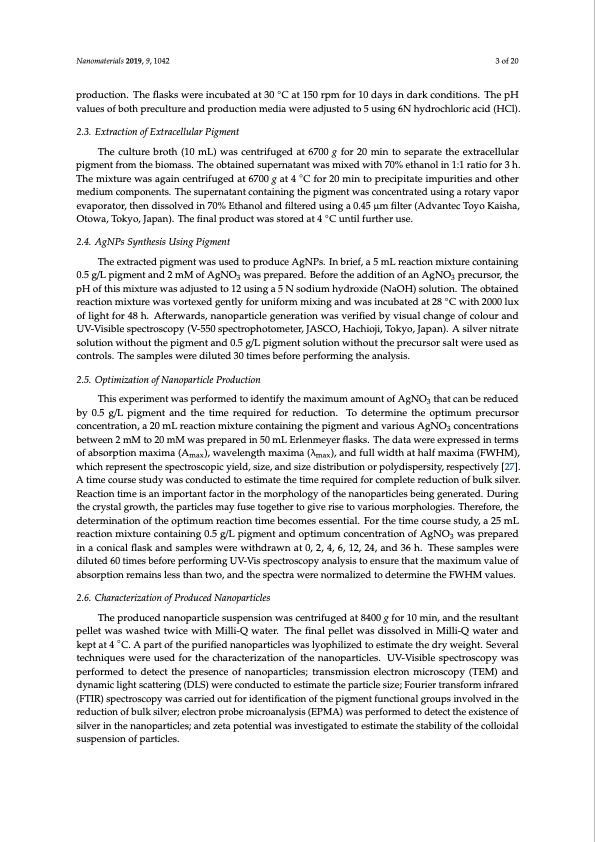
PDF Publication Title:
Text from PDF Page: 003
Nanomaterials 2019, 9, 1042 3 of 20 production. The flasks were incubated at 30 ◦C at 150 rpm for 10 days in dark conditions. The pH values of both preculture and production media were adjusted to 5 using 6N hydrochloric acid (HCl). 2.3. Extraction of Extracellular Pigment The culture broth (10 mL) was centrifuged at 6700 g for 20 min to separate the extracellular pigment from the biomass. The obtained supernatant was mixed with 70% ethanol in 1:1 ratio for 3 h. The mixture was again centrifuged at 6700 g at 4 ◦C for 20 min to precipitate impurities and other medium components. The supernatant containing the pigment was concentrated using a rotary vapor evaporator, then dissolved in 70% Ethanol and filtered using a 0.45 μm filter (Advantec Toyo Kaisha, Otowa, Tokyo, Japan). The final product was stored at 4 ◦C until further use. 2.4. AgNPs Synthesis Using Pigment The extracted pigment was used to produce AgNPs. In brief, a 5 mL reaction mixture containing 0.5 g/L pigment and 2 mM of AgNO3 was prepared. Before the addition of an AgNO3 precursor, the pH of this mixture was adjusted to 12 using a 5 N sodium hydroxide (NaOH) solution. The obtained reaction mixture was vortexed gently for uniform mixing and was incubated at 28 ◦C with 2000 lux of light for 48 h. Afterwards, nanoparticle generation was verified by visual change of colour and UV-Visible spectroscopy (V-550 spectrophotometer, JASCO, Hachioji, Tokyo, Japan). A silver nitrate solution without the pigment and 0.5 g/L pigment solution without the precursor salt were used as controls. The samples were diluted 30 times before performing the analysis. 2.5. Optimization of Nanoparticle Production This experiment was performed to identify the maximum amount of AgNO3 that can be reduced by 0.5 g/L pigment and the time required for reduction. To determine the optimum precursor concentration, a 20 mL reaction mixture containing the pigment and various AgNO3 concentrations between 2 mM to 20 mM was prepared in 50 mL Erlenmeyer flasks. The data were expressed in terms of absorption maxima (Amax), wavelength maxima (λmax), and full width at half maxima (FWHM), which represent the spectroscopic yield, size, and size distribution or polydispersity, respectively [27]. A time course study was conducted to estimate the time required for complete reduction of bulk silver. Reaction time is an important factor in the morphology of the nanoparticles being generated. During the crystal growth, the particles may fuse together to give rise to various morphologies. Therefore, the determination of the optimum reaction time becomes essential. For the time course study, a 25 mL reaction mixture containing 0.5 g/L pigment and optimum concentration of AgNO3 was prepared in a conical flask and samples were withdrawn at 0, 2, 4, 6, 12, 24, and 36 h. These samples were diluted 60 times before performing UV-Vis spectroscopy analysis to ensure that the maximum value of absorption remains less than two, and the spectra were normalized to determine the FWHM values. 2.6. Characterization of Produced Nanoparticles The produced nanoparticle suspension was centrifuged at 8400 g for 10 min, and the resultant pellet was washed twice with Milli-Q water. The final pellet was dissolved in Milli-Q water and kept at 4 ◦C. A part of the purified nanoparticles was lyophilized to estimate the dry weight. Several techniques were used for the characterization of the nanoparticles. UV-Visible spectroscopy was performed to detect the presence of nanoparticles; transmission electron microscopy (TEM) and dynamic light scattering (DLS) were conducted to estimate the particle size; Fourier transform infrared (FTIR) spectroscopy was carried out for identification of the pigment functional groups involved in the reduction of bulk silver; electron probe microanalysis (EPMA) was performed to detect the existence of silver in the nanoparticles; and zeta potential was investigated to estimate the stability of the colloidal suspension of particles.PDF Image | Biosynthesis of Silver Nanoparticles Talaromyces purpurogenus

PDF Search Title:
Biosynthesis of Silver Nanoparticles Talaromyces purpurogenusOriginal File Name Searched:
nanomaterials-09-01042.pdfDIY PDF Search: Google It | Yahoo | Bing
Turbine and System Plans CAD CAM: Special for this month, any plans are $10,000 for complete Cad/Cam blueprints. License is for one build. Try before you buy a production license. More Info
Waste Heat Power Technology: Organic Rankine Cycle uses waste heat to make electricity, shaft horsepower and cooling. More Info
All Turbine and System Products: Infinity Turbine ORD systems, turbine generator sets, build plans and more to use your waste heat from 30C to 100C. More Info
CO2 Phase Change Demonstrator: CO2 goes supercritical at 30 C. This is a experimental platform which you can use to demonstrate phase change with low heat. Includes integration area for small CO2 turbine, static generator, and more. This can also be used for a GTL Gas to Liquids experimental platform. More Info
Introducing the Infinity Turbine Products Infinity Turbine develops and builds systems for making power from waste heat. It also is working on innovative strategies for storing, making, and deploying energy. More Info
Need Strategy? Use our Consulting and analyst services Infinity Turbine LLC is pleased to announce its consulting and analyst services. We have worked in the renewable energy industry as a researcher, developing sales and markets, along with may inventions and innovations. More Info
Made in USA with Global Energy Millennial Web Engine These pages were made with the Global Energy Web PDF Engine using Filemaker (Claris) software.
Infinity Turbine Developing Spinning Disc Reactor SDR or Spinning Disc Reactors reduce processing time for liquid production of Silver Nanoparticles.
| CONTACT TEL: 608-238-6001 Email: greg@infinityturbine.com | RSS | AMP |